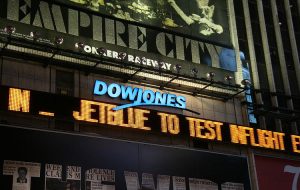Dow Jones falls on US credit downgrade, ADP employment beat, still outperforms other major indices
Share: Dow Jones futures fall 0.3% after Fitch downgrades US credit rating to AA+. DJIA is overbought on daily RSI as it trends higher near 35,750 resistance level. US July ADP Employment Change arrives at 324K, way above 189K expectation. Analysts expect Friday’s July Nonfarm Payrolls data to decline to 200K. The Dow

- Dow Jones futures fall 0.3% after Fitch downgrades US credit rating to AA+.
- DJIA is overbought on daily RSI as it trends higher near 35,750 resistance level.
- US July ADP Employment Change arrives at 324K, way above 189K expectation.
- Analysts expect Friday’s July Nonfarm Payrolls data to decline to 200K.
The Dow Jones Industrial Average (DJIA) opened half a percentage point lower on Wednesday after Fitch downgraded the US federal government’s credit rating. Since the market is risk-off, the Dow is tracking better than the riskier indices. The S&P 500 index has fallen 0.8% at the same time, while the NASDAQ Composite reversed 1.2%
However, the ADP Employment Change data for July arrived before the opening, and they provided a big surprise to the upside. The July data showed a positive change of 324K new jobs, well above the 189K expected by analysts. This reading tracked with the 497K ADP estimate from June, which was also an incredible upside surprise.
It is bad news for equity markets since it leads expectations higher for Friday’s Nonfarm Payrolls release. Higher employment gains lead to a tighter labor market and thus could provoke the Federal Reserve (Fed) to raise interest rates again in September.
Dow Jones Industrial Average News: Fitch surprises market with US downgrade
Fitch pulled a play right out of S&P Global Ratings’ playbook on Wednesday, releasing its downgrade on US government debt during the European morning session. S&P famously downgraded the US after a debt standoff in Congress in 2011.
Fitch dropped the US government one notch lower – from AAA to AA+. As it stands, this likely will not mean much for US Treasury yields since the US government borrows in its own currency. Still, the move has led to a sell-off at the riskier end of the market, and so relatively safer components of the Dow index are performing better than the tech and growth-heavy NASDAQ 100 index.
The US government recently overcame a debt standoff with the Republican-controlled House of Representatives in late May. Republicans had refused initially to raise the debt ceiling, but the Democratic Party, led by President Joe Biden, resolved the conflict by agreeing to some budget cuts and an increase in military spending. Fitch blamed an “erosion of governance” in the US and an expanding budget deficit for the downgrade.
IG Markets’ Alexandre Baradez told Bloomberg that she suspected the market was not all that worried about the rating cut but used it as an excuse to take profits. “I suspect that what’s currently being priced is the growing risk of an economic slowdown,” Baradez said. “The downward trend started to emerge yesterday on the back of disappointing Chinese and US data.”
In the case of the US, Baradez is referring to a disappointing July Manufacturing PMI that arrived at 46.4, below the 46.8 reading that analysts expected. The reading demonstrates that US manufacturing remains in a contractionary phase, but it was a tick-up from June.
Nonfarm payrolls could show soft landing or need for more hikes
The market has spent much of the week pondering whether the July Nonfarm Payrolls data will arrive as expected. Analyst consensus comes in at a flat 200K, just a bit below June’s 209K figure.
A much higher reading threatens to upend the soft landing thesis that many in the market have adopted. Even Federal Reserve Chair Jerome Powell said at his press conference on July 26 that a recession seemed less and less likely based on the current data.
A much higher NFP would suggest that the central bank might need to raise interest rates again to ensure that the US’s tight labor market does not lead this year’s pleasant disinflationary picture to end in favor of inflation stalling out near an annualized 4% rather than gradually tracking back to the Fed’s mandate for 2% core inflation.
The market wants July’s fed funds rate hike to be the end of the hiking cycle, and a figure slightly below or in line with 200K consensus would reinforce that narrative.
Additionally, analysts expect the Thursday release of July Services PMI to reflect a reading of 53, slightly down from June’s 53.9 figure. Service sector inflation has been harder for the Fed to control in 2023 than goods (manufacturing) inflation.
Earnings of the week
Wednesday, August 2 – CVS Health (CVS), Shopify (SHOP), PayPal (PYPL), Kraft Heinz (KHC), Humana (HUM)
Thursday, August 3 – Apple (AAPL), Amazon (AMZN), Amgen (AMGN), AirBNB (ABNB)
Friday, August 4 – Enbridge (ENB), Dominion Energy (D), fuboTV (FUBO)
What they said about the market – JP Morgan
JPMorgan surprised many traders on Monday by releasing a client note that said the much-hoped-for “soft landing” was an unlikely outcome for the market. The investment bank said that the Fed and other central banks were likely to keep interest rates high for longer than expected, which would likely hurt weaker companies on the periphery.
“We remain skeptical of this outcome, however, anticipating the inflation decline to prove incomplete, leaving restrictive policies in place that should increase private sector vulnerabilities and end the global expansion.”
Dow Jones FAQs
The Dow Jones Industrial Average, one of the oldest stock market indices in the world, is compiled of the 30 most traded stocks in the US. The index is price-weighted rather than weighted by capitalization. It is calculated by summing the prices of the constituent stocks and dividing them by a factor, currently 0.152. The index was founded by Charles Dow, who also founded the Wall Street Journal. In later years it has been criticized for not being broadly representative enough because it only tracks 30 conglomerates, unlike broader indices such as the S&P 500.
Many different factors drive the Dow Jones Industrial Average (DJIA). The aggregate performance of the component companies revealed in quarterly company earnings reports is the main one. US and global macroeconomic data also contributes as it impacts on investor sentiment. The level of interest rates, set by the Federal Reserve (Fed), also influences the DJIA as it affects the cost of credit, on which many corporations are heavily reliant. Therefore, inflation can be a major driver as well as other metrics which impact the Fed decisions.
Dow Theory is a method for identifying the primary trend of the stock market developed by Charles Dow. A key step is to compare the direction of the Dow Jones Industrial Average (DJIA) and the Dow Jones Transportation Average (DJTA) and only follow trends where both are moving in the same direction. Volume is a confirmatory criteria. The theory uses elements of peak and trough analysis. Dow’s theory posits three trend phases: accumulation, when smart money starts buying or selling; public participation, when the wider public joins in; and distribution, when the smart money exits.
There are a number of ways to trade the DJIA. One is to use ETFs which allow investors to trade the DJIA as a single security, rather than having to buy shares in all 30 constituent companies. A leading example is the SPDR Dow Jones Industrial Average ETF (DIA). DJIA futures contracts enable traders to speculate on the future value of the index and Options provide the right, but not the obligation, to buy or sell the index at a predetermined price in the future. Mutual funds enable investors to buy a share of a diversified portfolio of DJIA stocks thus providing exposure to the overall index.
Dow Jones chart forecast
The Dow Jones index advanced 0.66% last week and, through Tuesday of this week, has already added 0.48%. In the middle of the resistance zone ranging from 35,200 to 35,750, the Dow looks poised to at least reach the top of the range or even break through it.
The index already broke through the top trendline of the ascending wedge formation on July 20. In a word, it seems unbothered by technical resistance levels. The index has severely underperformed the NASDAQ 100 and S&P 500 indices so far in 2023, and many traders view it as a means of keeping one foot in the market without adopting risk-on positions.
A break of 35,750 will send bulls stretching for the next profit-taking range of 36,500 to 36,952. However, the Relative Strength Index (RSI) is again witnessing overbought levels, and the market may decide to trim soon. Levels of support are nearby at 34,712 and 34,590.
Dow Jones Industrial Average daily chart
.
لینک منبع : هوشمند نیوز
 آموزش مجازی مدیریت عالی حرفه ای کسب و کار Post DBA آموزش مجازی مدیریت عالی حرفه ای کسب و کار Post DBA+ مدرک معتبر قابل ترجمه رسمی با مهر دادگستری و وزارت امور خارجه |  آموزش مجازی مدیریت عالی و حرفه ای کسب و کار DBA آموزش مجازی مدیریت عالی و حرفه ای کسب و کار DBA+ مدرک معتبر قابل ترجمه رسمی با مهر دادگستری و وزارت امور خارجه |  آموزش مجازی مدیریت کسب و کار MBA آموزش مجازی مدیریت کسب و کار MBA+ مدرک معتبر قابل ترجمه رسمی با مهر دادگستری و وزارت امور خارجه |
 مدیریت حرفه ای کافی شاپ |  حقوقدان خبره |  سرآشپز حرفه ای |
 آموزش مجازی تعمیرات موبایل آموزش مجازی تعمیرات موبایل |  آموزش مجازی ICDL مهارت های رایانه کار درجه یک و دو |  آموزش مجازی کارشناس معاملات املاک_ مشاور املاک آموزش مجازی کارشناس معاملات املاک_ مشاور املاک |
برچسب ها :ADP ، Beat ، Credit ، Dow ، DowJones ، Downgrade ، Employment ، falls ، Indices ، Jones ، Major ، outperforms ، RatingAgencies ، Technical analysis
- نظرات ارسال شده توسط شما، پس از تایید توسط مدیران سایت منتشر خواهد شد.
- نظراتی که حاوی تهمت یا افترا باشد منتشر نخواهد شد.
- نظراتی که به غیر از زبان فارسی یا غیر مرتبط با خبر باشد منتشر نخواهد شد.





ارسال نظر شما
مجموع نظرات : 0 در انتظار بررسی : 0 انتشار یافته : ۰